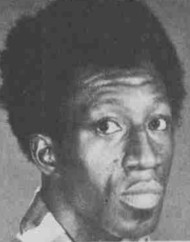sport.wikisort.org - Athlete
Gerald Govan (born January 2, 1942) is a retired American professional basketball player. He played nine seasons in the American Basketball Association (ABA), from 1967 to 1976.
 Govan, circa 1973 | |
| Personal information | |
|---|---|
| Born | January 2, 1942 Jersey City, New Jersey |
| Nationality | American |
| Listed height | 6 ft 10 in (2.08 m) |
| Listed weight | 220 lb (100 kg) |
| Career information | |
| High school | Snyder (Jersey City, New Jersey) |
| College | St. Mary of the Plains (1960–1964) |
| NBA draft | 1964 / Round: 11 / Pick: 88th overall |
| Selected by the St. Louis Hawks | |
| Position | Power forward / Center |
| Number | 25 |
| Career history | |
| 1967–1970 | New Orleans Buccaneers |
| 1970–1972 | Memphis Pros |
| 1972–1975 | Utah Stars |
| 1975–1976 | Virginia Squires |
| Career highlights and awards | |
| |
| Stats at Basketball-Reference.com | |
Born in Jersey City, New Jersey, Govan played high school basketball at Henry Snyder High School.[1]
A 6'10" forward/center from St. Mary of the Plains College, Govan spent nine years (1967–1976) in the now-defunct American Basketball Association, playing for the New Orleans Buccaneers, Memphis Pros, Utah Stars and Virginia Squires. He tallied 5,251 career points and 7,119 career rebounds, and he appeared in the 1970 ABA All-Star Game.
Govan is one of only six players to have participated in each of the original ABA's nine seasons of existence. The others are Freddie Lewis, Byron Beck, Stew Johnson, Bob Netolicky and Louie Dampier. Govan appeared in 681 regular season ABA games—4th all-time, and tops among players who never played in the NBA.
Nicknamed Go-Go, he was one of the rare basketball players who wore spectacles, black-framed glasses in particular.[2] He explained, "I tried contacts, but they bothered me. These glasses take away from my aggressiveness. I'm afraid of breaking them because if I do I got to pay for them myself."[3]
References
- Gerald Govan, Basketball-Reference.com. Accessed December 13, 2007.
- Fernandez, Bernard. "Moe, Larry and Go-Go: Reflecting on the New Orleans Buccaneers’ standout debut season," The Advocate (Baton Rouge, LA), Saturday, June 7, 2014. Retrieved June 20, 2022.
- Carry, Peter. "You make the most with what you got," Sports Illustrated, January 24, 1972. Retrieved June 20, 2022.
External links
На других языках
- [en] Gerald Govan
[ru] Гован, Джеральд
Джеральд Гован (англ. Gerald Govan; род. 2 января 1942 года в Джерси-Сити, Нью-Джерси, США) — американский профессиональный баскетболист, который выступал в Американской баскетбольной ассоциации, отыграв в ней все девять сезонов её существования.Другой контент может иметь иную лицензию. Перед использованием материалов сайта WikiSort.org внимательно изучите правила лицензирования конкретных элементов наполнения сайта.
WikiSort.org - проект по пересортировке и дополнению контента Википедии